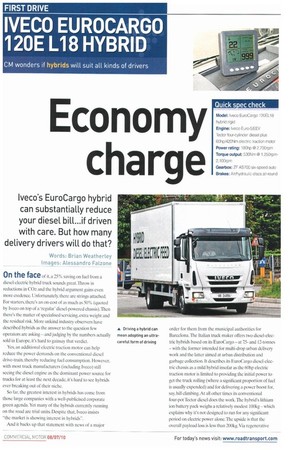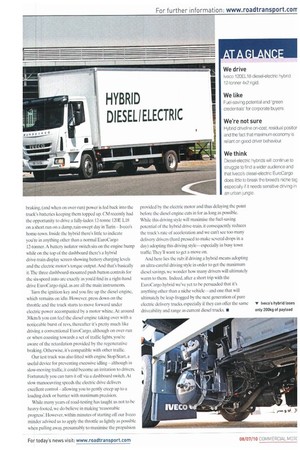Economy charge
Page 44

Page 45

If you've noticed an error in this article please click here to report it so we can fix it.
lveco's EuroCargo hybrid can substantially reduce your diesel bill...if driven with care. But how many delivery drivers will do that?
Words: Brian Weathertey
Images: Alessandro Falzone On the face of it, a 25% saving on fuel from a diesel-electric hybrid truck sounds great.Throw in reductions in CO2 and the hybrid argument gains even more credence. Unfortunately, there are strings attached. For starters, there's an on-cost of as much as 50% (quoted by Iveco on top of a 'regular' diesel-powered chassis).Then there's the matter of specialised servicing, extra weight and the residual risk. More unkind industry observers have described hybrids as the answer to the question few operators are asking—and judging by the numbers actually sold in Europe, it's hard to gainsay that verdict.
Yes, an additional electric traction motor can help reduce the power demands on the conventional diesel drive-train. thereby reducing fuel consumption. However. with most truck manufacturers (including Iveco) still seeing the diesel engine as the dominant power source for trucks for at least the next decade, it's hard to see hybrids ever breaking out of their niche.
So far, the greatest interest in hybrids has come from those large companies with a well-publicised corporate green agenda. Yet many of the hybrids currently running on the road are trial units. Despite that, Nee° insists "the market is showing interest in hybrids".
And it backs up that statement with news of a major order for them from the municipal authorities for Barcelona. The Italian truck maker offers two diesel-electric hybrids based on its EuroCargo— at 75and 12-tonnes — with the former intended for multi-drop urban delivery work and the latter aimed at urban distribution and garbage collection. It describes its EuroCargo diesel-electric chassis as a mild hybrid insofar as the 60hp electric traction motor is limited to providing the initial power to get the truck rolling (where a significant proportion of fuel is usually expended) and for delivering a power boost for. say, hill climbing. At all other times its conventional four-pot 'rector diesel does the work.The hybrid's lithium ion battery pack weighs a relatively modest IlOOkg — which explains why it's not designed to run for any significant period on electric power alone.The upside is that the overall payload loss is less than 200kg. Via regenerative
braking, (and when on over-run) power is fed back into the truck's batteries keeping them topped up. CM recently had the opportunity to drive a fully-laden 12-tonne 120E L18 on a short run on a damp, rain-swept day in Turin lveco's home-town. Inside the hybrid there's little to indicate you're in anything other than a normal EuroCargo 12-tonner. A battery isolator switch sits on the engine hump while on the top of the dashboard there's a hybrid drive-train display screen showing battery charging levels and the electric motor's torque output. And that's basically it. The three dashboard-mounted push button controls for the six-speed auto arc exactly as you'd find in a right-hand drive EuroCargo rigid, as are all the main instruments Turn the ignition key and you fire up the diesel engine, which remains on idle. However, press down on the throttle and the truck starts to move forward under electric power accompanied by a motor whine. At around 30km/h you can feel the diesel engine taking over with a noticeable burst of revs, thereafter it's pretty much like driving a conventional EuroCargo, although on over-run or when coasting towards a set of traffic lights, you're aware of the retardation provided by the regenerative braking. Otherwise, it's compatible with other traffic.
Our test truck was also fitted with engine Stop/Start, a useful device for preventing excessive idling although in slow-moving traffic, it could become an irritation to drivers. Fortunately you can turn it off via a dashboard switch. At slow manoeuvring speeds the electric drive delivers excellent control allowing you to gently creep up to a loading dock or barrier with maximum precision.
While many years of road-testing has taught us not to be heavy-footed, we do believe in making 'reasonable progress'. However, within minutes of starting off our lveco minder advised us to apply the throttle as lightly as possible when pulling away. presumably to maximise the propulsion provided by the electric motor and thus delaying the point before the diesel engine cuts in for as long as possible. While this driving style will maximise the fuel-saving potential of the hybrid drive-train, it consequently reduces the truck's rate of acceleration and we can't see too many delivery drivers (hard pressed to make several drops in a day) adopting this driving style—especially in busy town traffic. They'll want to get a move on.
And here lies the rub: if driving a hybrid means adopting an ultra-careful driving style in order to get the maximum diesel savings, we wonder how many drivers will ultimately warm to them. Indeed, after a short trip with the EuroCargo hybrid we've yet to be persuaded that it's anything other than a niche vehicle—and one that will ultimately he leap-frogged by the next generation of pure electric delivery trucks, especially if they can offer the same v lyeco's hybrid loses driveability and range as current diesel trucks. • only 200kg of payload




























































































































